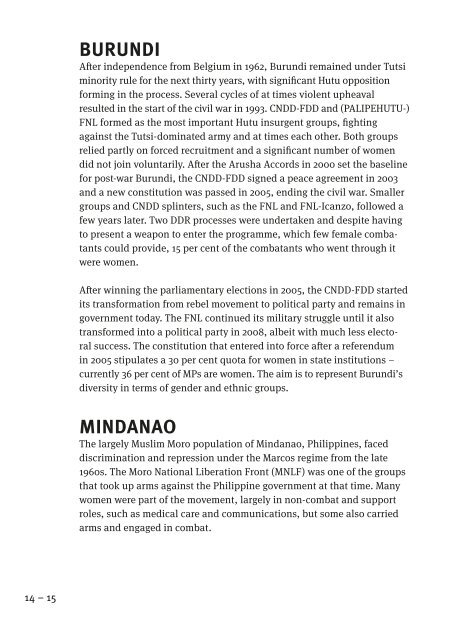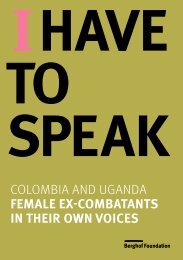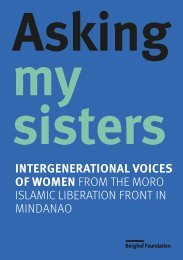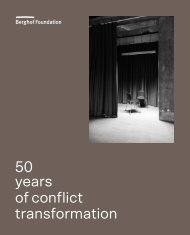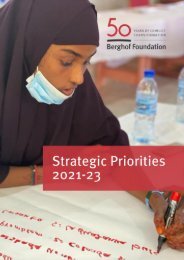I Have To Speak: Voices of Female Ex-Combatants from Aceh, Burundi, Mindanao and Nepal
This booklet seeks to amplify some of the hidden and forgotten voices in conflict. These stories of female ex-combatants from diverse political, religious, ethnic and national backgrounds show that women and their experiences of armed conflict have to be taken seriously for building sustainable peace. These are their stories as they tell them to each other. Six ex-combatant women collected the stories, reflecting as they did so on their reasons for joining the movements, their time as women in war, and how their lives unfolded once peace was restored. Theirs are stories of friendship and camaraderie, of life and death, of perseverance and resistance, and of rebuilding lives after war and continuing the struggle in peaceful ways.
This booklet seeks to amplify some of the hidden and forgotten voices in conflict. These stories of female ex-combatants from diverse political, religious, ethnic and national backgrounds show that women and their experiences of armed conflict have to be taken seriously for building sustainable peace.
These are their stories as they tell them to each other. Six ex-combatant women collected the stories, reflecting as they did so on their reasons for joining the movements, their time as women in war, and how their lives unfolded once peace was restored. Theirs are stories of friendship and camaraderie, of life and death, of perseverance and resistance, and of rebuilding lives after war and continuing the struggle in peaceful ways.
Create successful ePaper yourself
Turn your PDF publications into a flip-book with our unique Google optimized e-Paper software.
BURUNDI<br />
After independence <strong>from</strong> Belgium in 1962, <strong>Burundi</strong> remained under Tutsi<br />
minority rule for the next thirty years, with significant Hutu opposition<br />
forming in the process. Several cycles <strong>of</strong> at times violent upheaval<br />
resulted in the start <strong>of</strong> the civil war in 1993. CNDD-FDD <strong>and</strong> (PALIPEHUTU-)<br />
FNL formed as the most important Hutu insurgent groups, fighting<br />
against the Tutsi-dominated army <strong>and</strong> at times each other. Both groups<br />
relied partly on forced recruitment <strong>and</strong> a significant number <strong>of</strong> women<br />
did not join voluntarily. After the Arusha Accords in 2000 set the baseline<br />
for post-war <strong>Burundi</strong>, the CNDD-FDD signed a peace agreement in 2003<br />
<strong>and</strong> a new constitution was passed in 2005, ending the civil war. Smaller<br />
groups <strong>and</strong> CNDD splinters, such as the FNL <strong>and</strong> FNL-Icanzo, followed a<br />
few years later. Two DDR processes were undertaken <strong>and</strong> despite having<br />
to present a weapon to enter the programme, which few female combatants<br />
could provide, 15 per cent <strong>of</strong> the combatants who went through it<br />
were women.<br />
After winning the parliamentary elections in 2005, the CNDD-FDD started<br />
its transformation <strong>from</strong> rebel movement to political party <strong>and</strong> remains in<br />
government today. The FNL continued its military struggle until it also<br />
transformed into a political party in 2008, albeit with much less electoral<br />
success. The constitution that entered into force after a referendum<br />
in 2005 stipulates a 30 per cent quota for women in state institutions –<br />
currently 36 per cent <strong>of</strong> MPs are women. The aim is to represent <strong>Burundi</strong>’s<br />
diversity in terms <strong>of</strong> gender <strong>and</strong> ethnic groups.<br />
MINDANAO<br />
The largely Muslim Moro population <strong>of</strong> <strong>Mindanao</strong>, Philippines, faced<br />
discrimination <strong>and</strong> repression under the Marcos regime <strong>from</strong> the late<br />
1960s. The Moro National Liberation Front (MNLF) was one <strong>of</strong> the groups<br />
that took up arms against the Philippine government at that time. Many<br />
women were part <strong>of</strong> the movement, largely in non-combat <strong>and</strong> support<br />
roles, such as medical care <strong>and</strong> communications, but some also carried<br />
arms <strong>and</strong> engaged in combat.<br />
14 – 15


